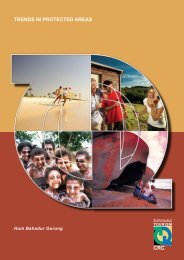icolls - Sustainable Tourism CRC
icolls - Sustainable Tourism CRC
icolls - Sustainable Tourism CRC
Create successful ePaper yourself
Turn your PDF publications into a flip-book with our unique Google optimized e-Paper software.
ECOLOGY, THREATS AND MANAGEMENT OPTIONS FOR SMALL ESTUARIES AND ICOLLS<br />
Title of paper: Predicting responses of New South Wales Coastal Lakes to changing nutrient loads<br />
Author: Barbara Robson<br />
Author's email: barbara.robson@csiro.au<br />
Abstract: The coast of New South Wales is dotted with more than 100 shallow lagoons that receive fresh water<br />
from their catchments and have intermittent or permanent connections to the ocean. As the human population<br />
continues to expand along the coast, coastal catchments are subject to increasing development pressure, which<br />
leads to changes in the quantity and quality of fresh water reaching coastal lagoons. To facilitate management of<br />
these ecosystems, there is a need for better understanding of their resilience and likely response to increased<br />
nutrient loads. In this study, an ecological box model with input from hydrodynamic and catchment models has<br />
been applied to eight New South Wales coastal lakes (Cudgen Lake, Coila Lake, Merimbula Lake, Back Lagoon,<br />
Burrill Lake, Narrawallee Inlet, the Myall Lake system and Lake Wollumboola). By applying the model with a<br />
range of nitrogen load scenarios, response curves have been generated for each system in terms of macroalgae,<br />
seagrass, microphytobenthos and phytoplankton biomass and seasonality. The results highlight the importance of<br />
factors such as lagoon area and morphology, residence time and denitrification efficiency in determining the<br />
sensitivity of coastal lagoons to changes in nitrogen loads. The study also indicates where more work is needed<br />
to fill gaps in essential data for these systems.<br />
Title of paper: A comparison of the Hydrodynamics of an Opening Event in two Coastal Lagoons<br />
Author: Emma Gale (UWA), Charitha Pattiaratchi (UWA), Roshanka Ranasinghe (DIPNR)<br />
Author's email: gale@cwr.uwa.edu.au<br />
Abstract: Intermittently Closing and Opening Lakes and Lagoons (ICOLL’s) are an important sub category of<br />
lagoons, and are characterised by their intermittent opening events to the ocean. The opening events, usually<br />
made artificially, are related to variable rainfall events that, over time, produce super-elevated lake levels that<br />
breach the beach berm and release the lake water to the ocean. An opening event introduces appreciable water<br />
level fluctuations (1-3m’s) accompanied by large salinity variability’s (7 – 30ppt) on a sub daily time scale and<br />
the duration and frequency of the opening may also vary between each ICOLL, from weeks to months, and inter<br />
and intra annually, respectively. The opening event for two ICOLLs, located in eastern Australia, Smiths Lake<br />
and Wamberal Lagoon, have been examined as a comparative study due to their similar bathymetry’s yet<br />
significantly different opening regimes. It has been found that the dominant physical forcing during these events<br />
appear to be a combination of low frequency sea level forcing, tidal forcing and an eroding-accreting inlet. The<br />
varying nature of these forcings and their interactions generate changes to the dominant processes controlling<br />
internal mixing and circulation, allowing the setup and breakdown of stratification, and the potential depletion of<br />
dissolved oxygen at depth. This talk shows that defining the hydrodynamics throughout the different stages of<br />
the opening event is important in understanding the water quality.<br />
Title of paper: Physical Processes of Intermittently Closed and Open Estuaries in South Africa<br />
Author: Piet Huizinga, Lara van Niekerk<br />
Author's email: p.huizinga@adept.co.za<br />
Abstract: The physical processes operating in the temporarily open and closed estuaries, including semi-closed<br />
systems will be discussed in the paper, by using examples from several studies of estuaries in South Africa.<br />
Approximately 70 per cent of the more than 250 estuaries in South Africa are intermittently closed and open.<br />
This aspect has a major influence on the ecological processes of these estuaries. Increases in closed mouth<br />
conditions can prevent fish and invertebrate recruitment from the sea into the estuary. Many of the small and<br />
very small estuaries in South Africa (often one to five km long) are temporary open and closed, but also some of<br />
the largest systems such as St Lucia, Bot and Swartvlei are in this category. The major force keeping the mouth<br />
of such an estuary open is the river flow, but large differences in river flow required to keep an inlet open occurs<br />
between different estuaries. For two small estuaries of similar size the differences in flow required to keep the<br />
inlet open can be twenty times or more. The river flow needed to maintain an open inlet is a major component of<br />
the freshwater requirements of estuaries and it is therefore most important that for each estuary this flow is<br />
determined. An interesting feature is that sometimes in small estuaries a semi-closed state of the inlet between<br />
open and closed can be distinguished. The inlet is then in a perched position on the sand berm and continuous<br />
over flow occurs from the estuary to the sea. However, this position can be so high that even at high tide influx<br />
of seawater into the estuary does not occur. This results in changes in the physico-chemical characteristics and<br />
biota of the estuary.<br />
56











